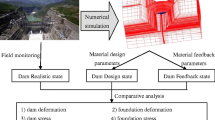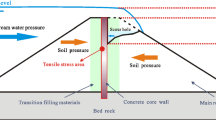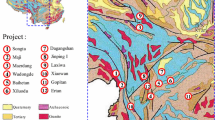Abstract
A grouting model is developed for use during the grouting of the complex foundation of a super high arch dam. The purpose as to determine the optimal grouting timing and appropriate grouting pressure involved in controlling the uplift deformation of the dam. The model determines the optimal grouting time as the height of the arch dam increases with the concrete pouring, by checking the tensile stresses in the dam against standard specifications. The appropriate grouting pressures are given on the basis of the actual grouting pressures monitored during the upstream riverbed foundation grouting. An engineering procedure, applying the model, was then proposed and used during foundation grouting under the toe block of the Xiluodu super high-arch dam in south-western China. The quality of the foundation grouting was evaluated against the results from pressurized water permeability tests, acoustic wave velocity tests, elastic modulus tests and panoramic photographing of the rockmass on completion of the foundation grouting. The results indicated that the proposed grouting model can be applied to effectively reduce the uplift deformation and associated cracking risk for super high arch dams, and it can be concluded that the proposed engineering grouting procedure is a valuable tool for improving foundation grouting under the toe blocks of a super high arch dam.















Similar content being viewed by others
References
ABAQUS (2001) ABAQUS/Standard User’s Manual. Hibbitt, Karlsson & Sorensen, Inc
ASCE (American Society of civil Engineers) (1974) Foundations for dams. Asilomar conference grounds pacific grove, California, March, New York
Ashikhmen VA, Pronina LE (1995) Regrouting joints and its effect on the stress-strain state of the Inguri Arch Dam: hydrotechnical construction. 28(10):569–580 (translated from: Gidrotekhnicheskoe Stroitel’stvo 1994;(10):1–9)
Babak N, Morteza O (2009) Effect of grout pressure and grout flow on soil physical and mechanical properties in jet grouting operations. Int J Rock Mech Min Sci 46(3):498–505
Baker WH (1982) Grouting in geotechnical engineering. American Society of Civil Engineers, Geo-Institute, Reston
Barla G, Debernardi D (2012) Sterpi D (2012) Time-dependent modeling of tunnels in squeezing, conditions. Int J Geomech 12:697–710
Casagrande A (1961) First rankine lecture: control of seepage through foundations and abutments of dams. Ge´otechnique 9(3):161–182
Cela JJL (2002) Material identification procedure for elastoplastic Drucker-Prager model. Journal Of Engineering Mechanics-asce 128(5):586–591
Chau PY (2004) Estimating cement take and grout efficiency on foundation improvement for Li-Yu-Tan dam. Eng Geol 75(1):1–14
Colominas I, Gómez-Calviño J, Navarrina F, Casteleiro M (2002) A general numerical model for grounding analysis in layered soils. Adv Eng Softw 33(7–10):641–649
Dai HL, Wang X, Xie GX, Wang XY (2004) Theoretical model and solution for the rheological problem of anchor-grouting a soft rock tunnel. Int J Press Vessels Pip 81(9):739–748
Eduardo MB, José VL, Paulo BL (2013) Hydromechanical analysis of masonry gravity dams and their foundations. Rock Mech Rock Eng 42(2):327–339
Eriksson M, Stille H, Andersson J (2000) Numerical calculations for prediction of grout spread with account for filtration and varying aperture. Tunn Undergr Space Technol 15(4):353–364
Ewert FK (1985) Rock grouting with emphasis on dam sites. Springer-Verlag, Berlin
Fransson Å, Tsang CF, Rutqvist J, Gustafson G (2010) Estimation of deformation and stiffness of fractures close to tunnels using data from single-hole hydraulic testing and grouting. Int J Rock Mech Min Sci 47(6):887–893
Grundy CF (1955) The treatment by grouting of permeable foundations of dams. France Int Comm Large Dams, 647–674
Ha¨ssler L (1991) Grouting of rock—simulation and classification. Doctoral thesis, Division of Soil and Rock Mechanics, Royal Institute of Technology, Stockholm, Sweden
Houlsby AC (1990) Construction and design of cement grouting—a guide to grouting in rock foundations. Wiley, New York
ICOLD (1964) the 17th ICOLD Congress: 17th Congress of the International Commission on Large Dam, P. 28. Vienna, Austria
ICOLD (1983) Deterioration of dams and reservoirs—examples and their analysis. ICOLD, Paris, France
Li LC, Tang CA, Fu YF (2009) Influence of heterogeneity on fracture behavior in multi-layered materials subjected to thermo-mechanical loading. Comput Mater Sci 46(3):667–671
Li LC, Tang CA, Li G, Wang SY (2012) Numerical simulation of 3d hydraulic fracturing based on an improved flow-stress-damage model and a parallel fem technique. Rock Mech Rock Eng 45(5):801–818
Liang ZZ, Xing H, Wang SY, Tang CA et al (2012) A three-dimensional numerical investigation of the fracture of rock specimens containing a pre-existing surface flaw. Comput Geotech 45:19–33
Lin P, Li QB, Hu H (2012) A flexible network structure for temperature monitoring of a super high arch dam. Int J Distr Sensor Networks 2012:10. doi:10.1155/2012/917849 (article ID 917849)
Lin P, Zhou YN, Liu HY, Wang C (2013) Reinforcement design and stability analysis for large-span tailrace bifurcated tunnels with irregular geometry. Tunn Undergr Space Technol 38(9):189–204. doi:10.1016/j.tust.2013.07.011
Lin P, Li QB, Jia PY (2014a) A real-time temperature data transmission approach for intelligent cooling control of mass concrete, Mathematical Problems in Engineering 2014:10. doi:10.1155/2014/514606 (article ID 514606)
Lin P, Ma TH, Liang ZZ, Tang CA, Wang RK (2014b) Failure and overall stability analysis on high arch dam based on DFPA code. Eng Fail Anal 45:164–184. doi:10.1016/j.engfailanal.2014.06.020
Lin P, Huang B, Li QB, Wang RK (2014c) Hazards and seismic reinforcement analysis for typical large dams following the Wenchuan earthquake. Eng Geol. doi:10.1016/j.enggeo.2014.05.011
Lin P, Liu XL, Zhou WY, Wang RK, Wang SY (2014d) Cracking, stability and slope reinforcement analysis relating to the Jinping dam based on a geomechanical model test. Arabian Journal of Geosciences. doi:10.1007/s12517-014-1529-1
Lin P, Zhou WY, Liu HY (2015) Experimental study on cracking, reinforcement and overall stability of the Xiaowan super-high arch dam. Rock Mech Rock Eng 48(2):819–841. doi:10.1007/s00603-014-0593-x
Lippold F (1958) Pressure grouting with packers. Proc ASCE J SMFE 84(SM-1) 1549:402–408
Lombardi G (1985) The role of cohesion in cement grouting of rock (Q 58, R 13). 15th congress of large dams. ICOLD, Lausanne, pp 235–261
Lombardi G (1992) The FES rock mass model—part 2: some examples. Dam Eng 3(3):201–221
Lombardi G, Deere D (1993) Grouting design and control using the GIN-principle. Water Power Dam Constr 15–22
Ma GY, Lin XS (2001) Grouting and ground water drainage in hydraulic and hydro-power. China Water Power Press
Maghous S, Saada Z, Dormieux L, Canou J, Dupla JC (2007) A model for in situ grouting with account for particle filtration. Comput Geotech 34(3):164–174
Ruggeri G (2004) Uplift pressures under concrete dams, ICOLD European Group
Sadeghiyeh SM, Hashemi M, Ajalloeian R (2013) Comparison of Permeability and Groutability of Ostur Dam Site Rock Mass for Grout Curtain Design. Rock Mech Rock Eng 42(2):341–357
Sedat T, Eray Ö, Hidayet T, Talip K (2002) Seepage problems in the karstic limestone foundation of the Kalecik Dam (south Turkey). Eng Geol 63(3–4):247–257
Serafim JL (1968) Rock mechanics in engineering practice. Influence of interstitial water on the behaviour of rock masses. Wiley, London, pp 55–97
Stille H, Gustafson G, Hassler L (2012) Application of new theories and technology for grouting of dams and foundations on rock. Geotech Geol Eng 30:603–624. doi:10.1007/s10706-012-9512-7
Sun Z (2004) Foundation grouting of large dam. China Water Power Press, Beijing (In Chinese)
Tano S, (1988) Foundation grouting in TENZAN dam. The dam digest, vol. 520–4. Japan Dam Foundation Society, Tokyo, pp 53–83
The China Energy Bureau (NEB) (2012) Technical specification for cement grouting construction of hydraulic structures (DL/T 5148-2012)
Uromeihy A, Barzegari G (2007) Evaluation and treatment of seepage problems at Chapar-Abad dam, Iran. Eng Geol 91(2–4):219–228
Verfel J (1989) Rock Grouting and Diaphragm Wall Construction. Elsevier, Amsterdam
Wang RK, Lin P, Zhou WY (2007) Cracking and stability problems of high arch dams on complicated rock foundations. Chin J Rock Mech Eng 26(10):1951–1958
Weaver K (1991) Dam Foundation Grouting. American Society of Civil Engineers, Geo-Institute, Reston, VA, Library of Congress Catalog, Card No, pp 91–34635
Widmann R (1996) International Society for Rock Mechanics Commission on Rock Grouting. Int J Rock Mech Min Sci Geomech Abstr 33(8):803–847
Zhang JX (2002) Seepage control of dam foundation and grouting technology. China Water Power Press, Beijing
Zhou JP, Du XH (2012) Characteristics and key technologies of super-high arch dam construction in China. Water Power 38(8):29–32
Zhou WY, Lin P, Zhou YN, Yang Q (2008) Research on concrete socket and peripheral joint for high arch dams foundation. Chin J Rock Mech Eng 27(10):1959–1967
Zhu XX, Lin P, Kang SZ, Li QB, Wang ZL (2012) Study on consolidation grouting effect for downstream block of high arch dams, 2nd International young scholars’ symposium on rock mechanics. Beijing; Rock mechanics, Achievements and ambitions, pp 745–748
Acknowledgements
This research work was supported by the National Natural Science Foundation of China (Grant Nos: 11272178, 51339003), the National Basic Research Program of China (973 Program) (Grant Nos. 2011CB013503, 2013CB035902), and the Tsinghua University Initiative Scientific Research Program. The authors are very grateful to the China Three Gorges Corporation and HydroChina Chengdu Engineering Corporation for supporting this study. The authors are also very grateful to Prof. Giovanni Barla, Elaine Anson and various anonymous reviewers for their critical recommendations, which have greatly helped the author to improve the paper.
Author information
Authors and Affiliations
Corresponding author
Rights and permissions
About this article
Cite this article
Lin, P., Zhu, X., Li, Q. et al. Study on Optimal Grouting Timing for Controlling Uplift Deformation of a Super High Arch Dam. Rock Mech Rock Eng 49, 115–142 (2016). https://doi.org/10.1007/s00603-015-0732-z
Received:
Accepted:
Published:
Issue Date:
DOI: https://doi.org/10.1007/s00603-015-0732-z




